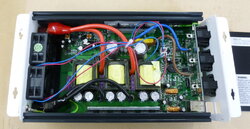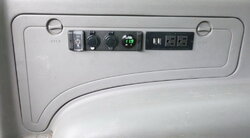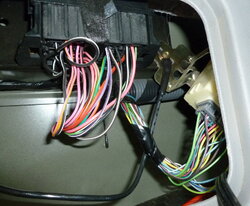Desert_AIP
Active Member
- Joined
- January 25, 2017
- Messages
- 97
- Reaction score
- 53
- Year, Model & Trim Level
- 1998 Explorer XLT 4WD
I use my 98 XLT for camping a lot. Usually it's just me and my wife, or one other person, and the rear seats are usually folded down.
So I don't need the rear HVAC or radio controls, and I already removed the CD changer and replaced it with the standard console insert.
That means I could remove the rear fan unit from under the console, that gave me a lot of space to mount an inverter.
I ran a 4 AWG cable through a 100A breaker in the engine compartment, then through the firewall through the grommet for the speedometer cable.
I used the duct under the console as a conduit to run the cable.
I mounted the inverter to the underside of the console steel with 1" nylon standoffs so it has a lot of airflow around it.
I was originally planning a 500W unit, but you can't run much off of that.
I mounted a distribution block with one 4 AWG input and four 8 AWG outputs and a 100A ANL fuse holder to the rear of the steel console skeleton.
I used a couple of the office plug in power strips that have 120V and USB ports, and just plugged them into the inverter outlets.
One in the rear of the console where the rear radio and HVAC controls were, and one in the rear cargo area.
There is also an 8 AWG wire that runs through a 20A fuse into the rear cargo area for 12V outlets to a panel with a 15A breaker/switch.
I had to wire a new on off switch for the inverter that I'll install in the slot for the old Kleenex box holder in the console. Still need to build the box for it.
I plan on upgrading the alternator to a 200A unit.
So I don't need the rear HVAC or radio controls, and I already removed the CD changer and replaced it with the standard console insert.
That means I could remove the rear fan unit from under the console, that gave me a lot of space to mount an inverter.
I ran a 4 AWG cable through a 100A breaker in the engine compartment, then through the firewall through the grommet for the speedometer cable.
I used the duct under the console as a conduit to run the cable.
I mounted the inverter to the underside of the console steel with 1" nylon standoffs so it has a lot of airflow around it.
I was originally planning a 500W unit, but you can't run much off of that.
I mounted a distribution block with one 4 AWG input and four 8 AWG outputs and a 100A ANL fuse holder to the rear of the steel console skeleton.
I used a couple of the office plug in power strips that have 120V and USB ports, and just plugged them into the inverter outlets.
One in the rear of the console where the rear radio and HVAC controls were, and one in the rear cargo area.
There is also an 8 AWG wire that runs through a 20A fuse into the rear cargo area for 12V outlets to a panel with a 15A breaker/switch.
I had to wire a new on off switch for the inverter that I'll install in the slot for the old Kleenex box holder in the console. Still need to build the box for it.
I plan on upgrading the alternator to a 200A unit.
Attachments
-
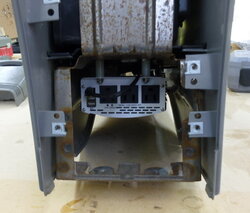 Inverter_24.JPG115.2 KB · Views: 147
Inverter_24.JPG115.2 KB · Views: 147 -
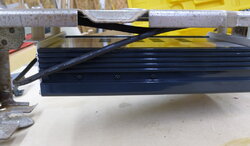 Inverter_21.JPG144 KB · Views: 155
Inverter_21.JPG144 KB · Views: 155 -
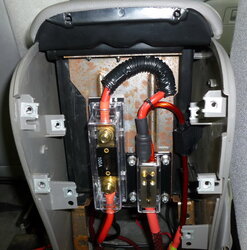 Inverter_26.JPG184 KB · Views: 147
Inverter_26.JPG184 KB · Views: 147 -
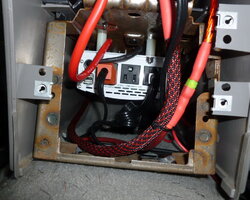 Inverter_33.JPG229.2 KB · Views: 144
Inverter_33.JPG229.2 KB · Views: 144 -
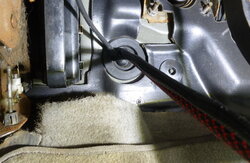 Lighting%20Control_31.JPG241 KB · Views: 152
Lighting%20Control_31.JPG241 KB · Views: 152 -
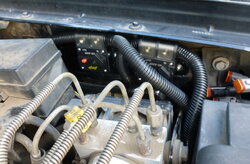 Lighting%20Control_42.JPG195.5 KB · Views: 146
Lighting%20Control_42.JPG195.5 KB · Views: 146 -
 Lighting%20Control_57.JPG224.6 KB · Views: 139
Lighting%20Control_57.JPG224.6 KB · Views: 139 -
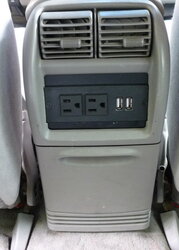 Inverter_41.JPG94.3 KB · Views: 152
Inverter_41.JPG94.3 KB · Views: 152

